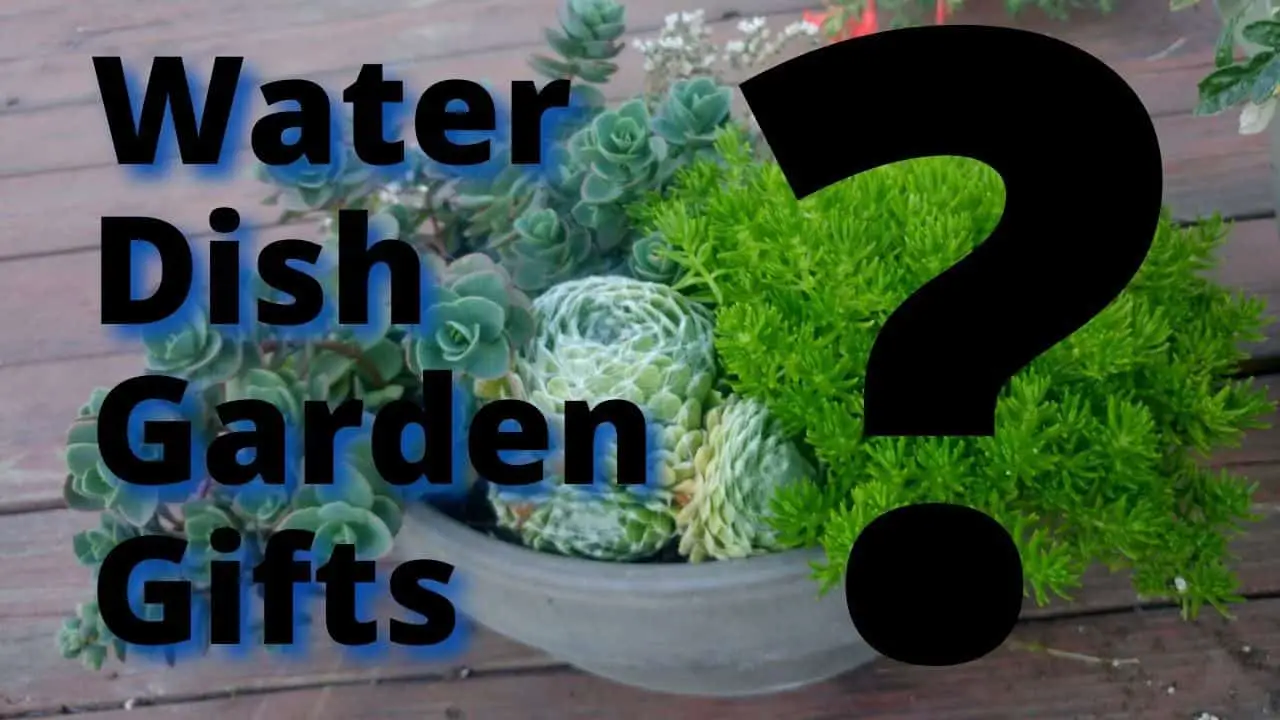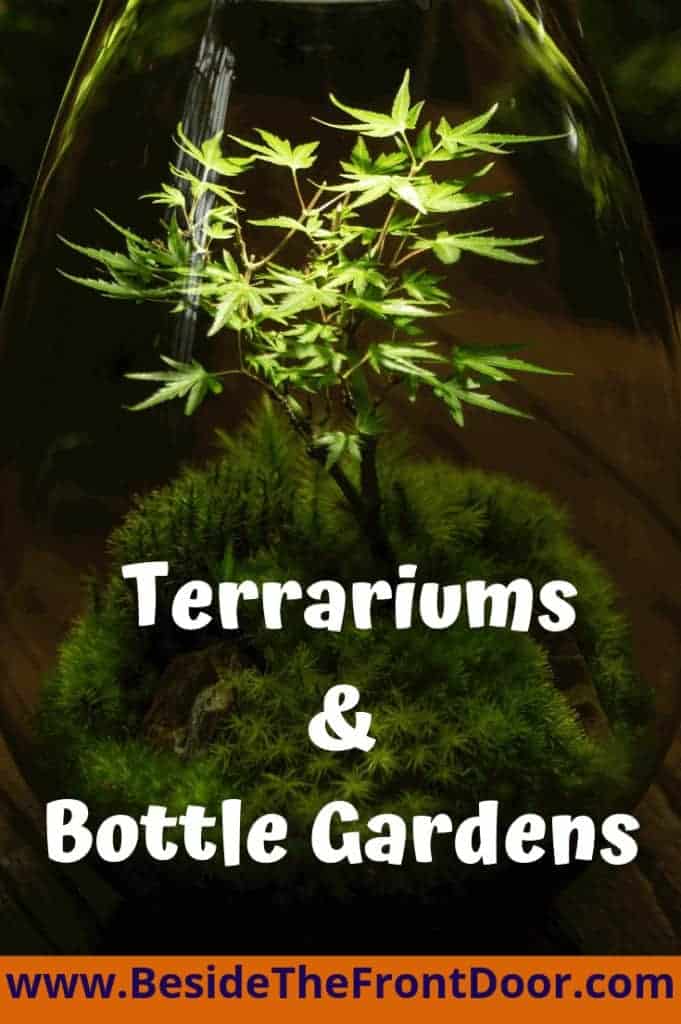There is so much more to terrariums today. You can make a desert landscape with cacti and succulents. You can showcase a single specimen. You can have a traditional tropical terrarium, and more.
What about animals and pools of water? Let’s explore the different types, what containers are best used for each, how to build and how to maintain them.
What is a terrarium?
A terrarium is a, usually enclosed, clear space used to grow plants, controlling moisture.
Terrariums have the soil and the plant encased like a miniature ‘garden in a bottle’.
What is a Wardian case?
A Wardian case is a terrarium, that looks like a miniature greenhouse, with straight sides and a peaked roof. These are named after Nathaniel Bagshaw Ward
Who used the first terrariums in 1842 to transport plant specimens, over the long sea voyages, alive.
These became very popular in Victorian England and continue to have resurgences of popularity ever since.
What is a bottle garden?
A bottle garden is another name for a terrarium, which uses a bottle as a container.
What is a vivarium?
A vivarium is a terrarium that includes animals as well as plant life, such as turtles. I have not had any animals that would live in an enclosed space like that. These are pets that are allowed by most rentals, so I expect popular in the city 🙂
An aquarium I have had, but that is a different story…
There are two basic types of terrariums:
- Open, as the name suggests, is left open to exchange moisture and air with the surrounding room. These require more watering, but less likely to develop root rot. Overall much easier to start and manage for the beginner.
- Closed. These terrariums are sealed to preserve and recycle moisture within the bottle.
Especially in the initial construction, it is important to be able to open the terrarium to adjust the moisture within until the proper balance has been achieved.
This is very much a ‘Goldielocks and the Three Bears’ situation. It needs to be Just right. Not too much to encourage rot, and enough for the plants to thrive.
These also need to be kept in bright light, but NOT in direct sun. The heat builds up very fast and you will cook your plants rather than grow them.
Something that has caught my eye of late is the Ultimate Closed Biosphere, which I think of more as an aquarium, but being sealed places it also in the terrarium camp, but it has animals so it is a vivarium. OK, so it is in a class by itself, but I must get one of these for Christmas this year, and one for my black thumb friends as well. I think it is perfect for the office, with no water to spill on the electronics, nothing to feed while you are on vacation! Check them out here at Amazon. The Ultimate Closed Biosphere
But I digress into my gift-giving planning mode…… back to terrariums, which make a unique gift as well. Make them, spend a couple of weeks getting the moisture right, working out how much, how often that particular terrarium is needing ( as well as allowing time to fill in enough to be lush), and present with an instruction booklet to the recipient. This setting up and stabilizing step is where most people stumble, so it will be so appreciated that step is passed. Just as an aside, make more than you plan to give away, just as insurance. Keep the extra!
Desert
These terrariums are rising in popularity recently, but do have some special needs that need to be watched for. Deserts are very low humidity environments. So that means the plants are adapted to low humidity. Most terrariums create higher humidity….see where I am going with this? More than ‘just waterless’, having the proper amount of water for the cacti and succulents will still leave the humidity too high in a traditional terrarium for longer-term survival.
This is where those newer, open-air ‘terrariums’ have been introduced. These are really more decorative clear pots that have must higher edges than the soil level. These have wide open tops to allow the moisture to escape and release humidity. These are what you need to use if you want cacti or succulents in a terrarium-type planter.
I love these two you can easily get from Amazon.
A gorgeous re-purposed glass ice bucket
Tropical
These are the traditional uses of terrariums. These are the plants that thrive in the special conditions of terrariums. Bright, but indirect light and high humidity. These include most of your commonly found houseplants as well as Epiphytes, air plants, orchids, and bromeliads. The limiting factor here for terrarium design is, have a terrarium large enough to actually grow these. I would not recommend growing a fiddle leaf fig or an ostrich fern in a terrarium no matter how little it looks now, as a baby plant! Observe typical sizes of leaves and growth habits as seen at your garden center typically, THEN go to the baby terrarium plant area to pick out with your favorites in mind.
If you are making an entire scene, think fairy garden if that helps you, when choosing. Tiny leaves in proportion with the size of the terrarium.
A few great traditional terrarium containers are:
This one is molten glass and wood.. every one different and in several sizes from Amazon.
…and this traditional Gallon jug for a closed terrarium.
Another terrarium is a single specimen terrarium. This is particularly suited for a showcase orchid, bromeliad or your favorite fern. This can be planted in, as a traditional terrarium, or showcased like in a cloche. The showcase can be changed out easily by opening, swapping the inside potted plant, and reclosing. A great last-minute hack to elevate the look of any plant!
This glass cloche is a classy and functional way to do just that!
Or this modern take on a Wardian case..
How do you make a terrarium?
There are so many different types of terrariums that no 1 way right for them all, but there are several basics that are fairly universal and a good place to start.
- Find the container and the plants for your terrarium. Now which comes first? Plants or container? Do you already have the container? Then go searching for plants that are appropriate for the scale of your terrarium container, and type (desert or tropical). If you have the plant or plants, go search for the container appropriate, again scale and type. Desert or tropical.
2. Spoon or slide in a layer of clean, damp gravel 1” deep.
3. Cover with a layer of damp, activated charcoal at least ½” deep.
4. Add an inch of moistened soil next.
What soil is best for a terrarium?
A sterile, quickly draining potting soil. Notice I said potting soil, not flower soil, or raised bed soil, or topsoil. Use one labeled potting soil. The drainage and tiny spaces for oxygen are just right for what you want.
If you are building a desert terrarium, use cactus soil. This is often a peat moss-based mix with a washed sand component.
Sterile potting soil will set you on the right path to a fresh smelling, thriving terrarium.
5. Add plants.
What plants grow in a terrarium?
For a classic tropical terrarium, some great choices to start with are:
Tropical terrarium:
- Peperomia
- Moss (Thuidium Delicatulum)
- African violet
- Fittonia
- Hypoestes
- Friendship Plant (Pilea involucrata)
- Philodendron
- Tradescantia
- Ferns:
- Boston (Nephrolepis exaltata)
- Button fern (Pellaea rotundifolia)
- Heart fern (Hemionitis arifolia)
- Rabbit’s foot fern (Davallia)
- ET Fern (Polypodium formosanum ‘Cristatum’)
- Bird’s nest fern (Asplenium nidus)
Medium Moist terrarium (some humidity, soil allowed to dry between waterings):
- Rex begonias
- Earth stars (Cryptanthus)
- Mistletoe cactus (Rhipsalis ewaldiana)
- Bromeliads (Neoregelia)
- Orchids
- Leptotes
- Potinara
- Macodes petola
Dry Open Terrarium
- String of Pearls
- Aloe
- Zebra Plant (Haworthia)
- Ox Tongue (Gasteria)
- Dunkard’s Bones (Hatiora salicornioides)
- Various succulent & Cacti
There are so many more, just about anything can be grown in a terrarium as long as all the plants chosen like the same conditions and will fit in your chosen container. Start with tiny babies, in 3” pots or less.
Do terrariums need light?
Yes, all plants need light to photosynthesis to live, but terrariums should not be in direct, full sun. The glass intensifies the heat build-up from the direct sun, so filtered light, or bright indirect light is best.
How to water a terrarium.
If a closed terrarium, water only you do not get any condensation on the sides for most plants. Open and trickle in only a small amount, a teaspoon to a ¼ cup depending on the terrarium size. And reclose the container. Keep a close eye every day to see if that was too much and leave the cover off for excess to evaporate if a lot of condensation develops on the sides.
Terrariums will need a fraction of the water you are used to giving your indoor plants, so start with tiny amounts, gently sprinkled in or trickled down the sides, let it sit overnight, and evaluate if more is needed. If the next day has condensation dripping down the sides, then leave open to evaporate the excess. If no condensation at all, unless a desert terrarium, add a little more.
Related Questions:
What is a terrarium with water called?
Paludarium is a combination or a terrarium (terra- earth, arium- a place for relating to) and a body of water element. If it holds animals it is commonly called a vivarium.
Can I use moss from my yard in a terrarium?
Yes, but there is a multitude of varieties of moss. Thriving in conditions from sun to deep shade, from wet to quite dry, from having a dormancy period to growing all year. The moss in your yard may work fine, give it a try, why not? If you are giving as a gift and need to be sure you have varieties that will like the conditions of a terrarium, purchase some selected for that purpose.
-
Reblooming A Poinsettia

Do you hate throwing out your poinsettia each year? Want to save it and rebloom it next holiday season, but was told it was too difficult? Here is how, step
-
Do Houseplants Help With Dust? Really? Science Research Discovers…

It is widespread knowledge that plants help filter the air from toxins, but do they help control other airborne pollutants like particulate matter, aka, dust? Do Houseplants remove dust from
-
How To Water A Combination Dish Garden

Did you get a beautiful dish garden as a gift? These are wonderful, thoughtful, and beautiful gifts and a welcome break from cut flowers Your dish garden can grow on,











